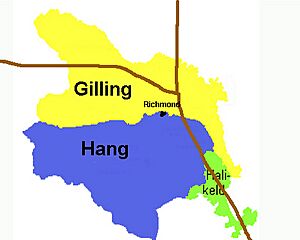Honour of Richmond facts for kids
| Honour of Richmond Richmondshire |
|
| Geography | |
| HQ | Richmond |
| History | |
| Succeeded by | Richmondshire (an equivalent non-metropolitan district after the honour had long been disbanded) |
Quick facts for kids Subdivisions |
|
|---|---|
| Type | Wapentakes and manors |
| Units |
|
The Honour of Richmond (also called Richmondshire) was a very important feudal barony in old England. Think of a barony as a huge area of land controlled by a powerful lord. Today, most of this land is in North Yorkshire.
Before the Honour of Richmond was created, this land belonged to a powerful earl named Edwin, Earl of Mercia. After he died in 1071, King William the Conqueror gave this land to Count Alan Rufus. This was a special gift to thank Alan for his help during the Norman Conquest of England. This happened sometime between 1068 and 1071.
The Honour of Richmond was one of the most important areas in Norman England. It was made up of 60 "knight's fees." A knight's fee was enough land to support one knight and his family. Alan Rufus built a strong castle in the area, which we now know as Richmond Castle. This castle became the main base for the Honour.
Contents
What Was the Honour of Richmond?
The Honour of Richmond was a large territory. It stretched about 60 kilometers from east to west and 45 kilometers from north to south. It covered most of the land between the River Tees and the River Ure. The landscape changed a lot, from the high, rocky Pennines mountains to the flat, rich farmlands of the Vale of York.
The main base, or "caput," of the Honour was first in a place called Gilling. But Count Alan soon moved it to Richmond Castle. Even though Richmond Castle was in ruins by the 1500s, it was later fixed up. Today, it's a popular place for tourists to visit.
For most of its history, the Honour was divided into three main areas called wapentakes. These were like smaller districts within the Honour. The three wapentakes were Hang, Gilling, and Hallikeld.
Gilling Wapentake
The Gilling wapentake was mainly located between the River Tees to the north and the River Wiske to the east. The County of Durham was on the other side of the River Tees. To the south, the land bordered the Hang Wapentake, following the hills between the River Swale and the River Ure. The western border was the Pennines mountains.
Hang Wapentake
The Hang wapentake had the River Swale as its northern border. Its western border was also the Pennine mountains. To the south, it followed the hills that separated it from the River Wharfe and the River Nidd. The eastern border followed smaller streams. The people of this wapentake would meet at a place on the Hang Beck in the Finghall area.
Hallikeld Wapentake
The third part of the Honour, Hallikeld, included the areas between the River Ure and the River Swale. These two rivers eventually join together at a place called Ellenthorpe.
Who Ruled the Honour of Richmond?
The people who ruled the Honour of Richmond were often called the Lords of Richmond. Sometimes, the title of "Earl of Richmond" or "Duke of Richmond" was held by different people or even by the King. The ownership of the Honour could change a lot, especially during times of war or political changes.
Here are some of the important people who held the Honour of Richmond:
- Alan Rufus (died 1093): He was the first lord, given the land by William the Conqueror. He had no children.
- Alan the Black (died 1098): Alan Rufus's brother. He also had no children.
- Stephen, Count of Tréguier (died 1135/6): Another brother.
- Alan, 1st Earl of Richmond (died 1146): Stephen's younger son.
- Conan IV, Duke of Brittany (died 1171): Alan's son. His daughter, Constance, became the heir.
- King Henry II: He looked after the Honour when Constance was a child.
- Constance, Duchess of Brittany (died 1201): Conan's daughter and the rightful Countess of Richmond.
- Geoffrey II, Duke of Brittany (died 1186): Constance's first husband.
- Ranulph, Earl of Chester (died 1232): Constance's second husband.
- Guy of Thouars: Constance's third husband. He lost the Honour to King John in 1203.
- Alix, Duchess of Brittany (died 1221): Constance and Guy's older daughter.
- Peter I, Duke of Brittany (also known as Pierre Mauclerc): Alix's husband. He sometimes held the Honour, but it depended on whether he was loyal to the English or French King.
- William of Savoy (granted 1236): A bishop who was given the Honour.
- Peter II, Count of Savoy (granted 1240): He was also known as the Earl of Richmond.
- John II, Duke of Brittany (died 1305): Peter II lost control of the Honour to John, who was married to Princess Beatrice.
- John of Brittany, Earl of Richmond (died 1334): John II's son. He had no children.
- John III, Duke of Brittany (1286–1341): John of Brittany's nephew.
- John de Montfort: The Earldom went back to the King in 1342.
- John of Gaunt: A very powerful English prince.
- John IV, Duke of Brittany: John of Montfort's son. He lost the Honour permanently in 1384 because he was loyal to the French King.
- Ralph de Neville, 1st Earl of Westmorland: He held the Honour for his lifetime.
- John of Lancaster, 1st Duke of Bedford: A son of King Henry IV.
- Edmund Tudor, 1st Earl of Richmond: The father of King Henry VII.
- Henry Tudor: He became King of England and the Honour became part of the Crown's lands.
- Charles Lennox: The Honour was given to the Lennox family in 1675 by King Charles II.


